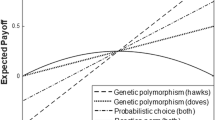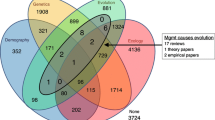Summary
Richard Levins introduced fitness sets as a tool for investigating evolution within heterogeneous environments. Evolutionary game theory permits a synthesis and generalization of this approach by considering the evolutionary response of organisms to any scale of habitat heterogeneity. As scales of heterogeneity increase from fine to coarse, the evolutionary stable strategy (ESS) switches from a single generalist species to several species that become increasingly specialized on distinct habitats. Depending upon the organisms' ecology, the switch from one to two species may occur at high migration rates (relatively fine-grained environment), or may only occur at very low migration rates (coarse-grained environment). At the ESS, the evolutionary context of a species is the entire landscape, while its ecological context may be a single habitat.
Evolution towards the ESS can be represented with adaptive landscapes. In the absence of frequency-dependence, shifting from a single strategy ESS to a two strategy ESS poses the problem of evolving across valleys in the adaptive surface to occupy new peaks (hence, Sewell Wright's shifting balance theory). Frequency-dependent processes facilitate evolution across valleys. If a system with a two strategy ESS is constrained to possess a single strategy, the population may actually evolve a strategy that minimizes fitness. Because the population now rests at the bottom of a valley, evolution by natural selection can drive populations to occupy both peaks.
Similar content being viewed by others
References
Abrams, P. A. (1986) Character displacement and niche shift analyzed using consumer-resource models of competition.Theor. Pop. Biol. 29, 107–60.
Abrams, P. A. (1987) Alternate models of character displacement. I. Displacement when there is competition for nutritionally essential resources.Evolution 41, 651–61.
Abrams, P. A. (1990) Mixed responses to resource densities and their implications for character displacement.Evol. Ecol. 4, 93–102.
Brew, J. S. (1982) Niche shift and the minimization of competition.Theor. Pop. Biol. 22, 367–81.
Brown, J. S. (1990) Habitat selection as an evolutionary game.Evolution 44, 732–46.
Brown, J. S. and Vincent, T. L. (1987) Coevolution as an evolutionary game.Evolution 41, 66–79.
Comins, H. N., Hamilton, W. D. and May, R. (1980). Evolutionarily stable dispersal strategies.J. Theor. Biol. 82, 205–230.
Feder, J. L., Chilcote, C. A. and Bush, G. L. (1988) Genetic differentiation and sympatric host races of the apple maggot fly,Rhagoletis pomonella.Nature (London)336, 61–4.
Fretwell, S. D. and Lucas Jr., H. L. (1970) On territorial behavior and other factors influencing habitat distribution in birds. I. Theoretical development.Acta Biotheor. 19, 16–36.
Hamilton, W. D. and May, R. (1977) Dispersal in stable environments.Nature (London)269, 578–81.
Holt, R. D. (1985) Population dynamics in two-patch environments: Some anomalous consequences of an optimal habitat distribution.Theor. Pop. Biol. 28, 181–208.
Holt, R. D. and Gaines, M. S. (1992) Analysis of adaptation in heterogeneous landscapes: implications for the evolution of fundamental niches.Evol. Ecol. 6, 433–47.
Kotler, B. P. and Brown, J. S. (1988) Environmental heterogeneity and the coexistence of desert rodents.Ann. Rev. Ecol. Syst. 19, 281–307.
Lawlor, L. R. and Maynard Smith, J. (1976) The coevolution and stability of competing species.Am. Nat. 110, 79–99.
Levin, S., Cohen, D. and Hastings, A. (1984) Dispersal strategies in patchy environments.Theor. Pop. Biol. 26, 165–91.
Levins, R. (1962) Theory of fitnesses in a heterogeneous environment, I. The fitness set and adaptive function.Am. Nat. 96, 361–78.
Levins, R. (1968)Evolution in Changing Environments. Princeton University Press, Princeton, New Jersey.
Matsuda, H. and Namba, T. (1989) Co-evolutionarily stable community structure in a patchy environment.J. Theor. Biol. 136, 229–43.
Maynard Smith, J. and Price, G. R. (1973) The logic of animal conflict.Nature (London)246, 15–18.
Morris, D. W. (1992) Scales and costs of habitat selection in heterogeneous landscapes.Evol. Ecol. 6, 412–32.
Pease, C. M., Lande, R. and Bull, J. J. (1989) A model of population growth, dispersal, and evolution in a changing environment.Ecology 70, 1657–64.
Pulliam, H. R. (1988) Sources, sinks, and population regulation.Am. Nat. 132, 652–61.
Rice, W. R. and Salt, G. W. (1990) The evolution of reproductive isolation as a correlated character under sympatric conditions: experimental evidence.Evolution 44, 1140–52.
Rosenzweig, M. L. (1978) Competitive speciation.Biol. J. Linn. Soc. 10, 275–89.
Rosenzweig, M. L. (1981) A theory of habitat selection.Ecology 62, 327–35.
Rosenzweig, M. L. (1987) Habitat selection as a source of biological diversity.Evol. Ecol. 1, 315–30.
Roughgarden, J. (1976) Resource partitioning among competing species — a coevolutionary approach.Theor. Pop. Biol. 9, 388–424.
Slatkin, M. (1980) Ecological character displacement.Ecology 61, 163–77.
Slatkin, M. (1985) Gene flow in natural populations.Ann. Rev. Ecol. Syst. 16, 393–430.
Taper, M. L. and Case, T. J. (1985) Quantitative genetic models for the coevolution of character displacement.Ecology 66, 355–71.
Taper, M. L. and Case, T. J. (1992) Models of character displacement and the theoretical robustness of taxon cycles.Evolution 46, 317–33.
Tilman, D. (1982)Resource Competition and Community Structure. Princeton University Press, Princeton, NJ, USA.
Venable, D. L. and Brown, J. S. (1988) The selective interactions of dispersal, dormancy, and seed size as adaptations for reducing risk in variable environments.Am. Nat. 131, 360–84.
Vincent, T. L. and Brown, J. S. (1984) Stability in an evolutionary game.Theor. Pop. Biol. 26, 408–27.
Vincent, T. L. and Brown, J. S. (1988) The evolution of ESS theory.Ann. Rev. Ecol. Syst. 19, 423–43.
Wright, W. (1977)Evolution and Genetics of Populations. Vol. 3, Experimental Results and Evolutionary Deductions. University of Chicago Press, Chicago, IL, USA.
Author information
Authors and Affiliations
Rights and permissions
About this article
Cite this article
Brown, J.S., Pavlovic, N.B. Evolution in heterogeneous environments: Effects of migration on habitat specialization. Evol Ecol 6, 360–382 (1992). https://doi.org/10.1007/BF02270698
Issue Date:
DOI: https://doi.org/10.1007/BF02270698




